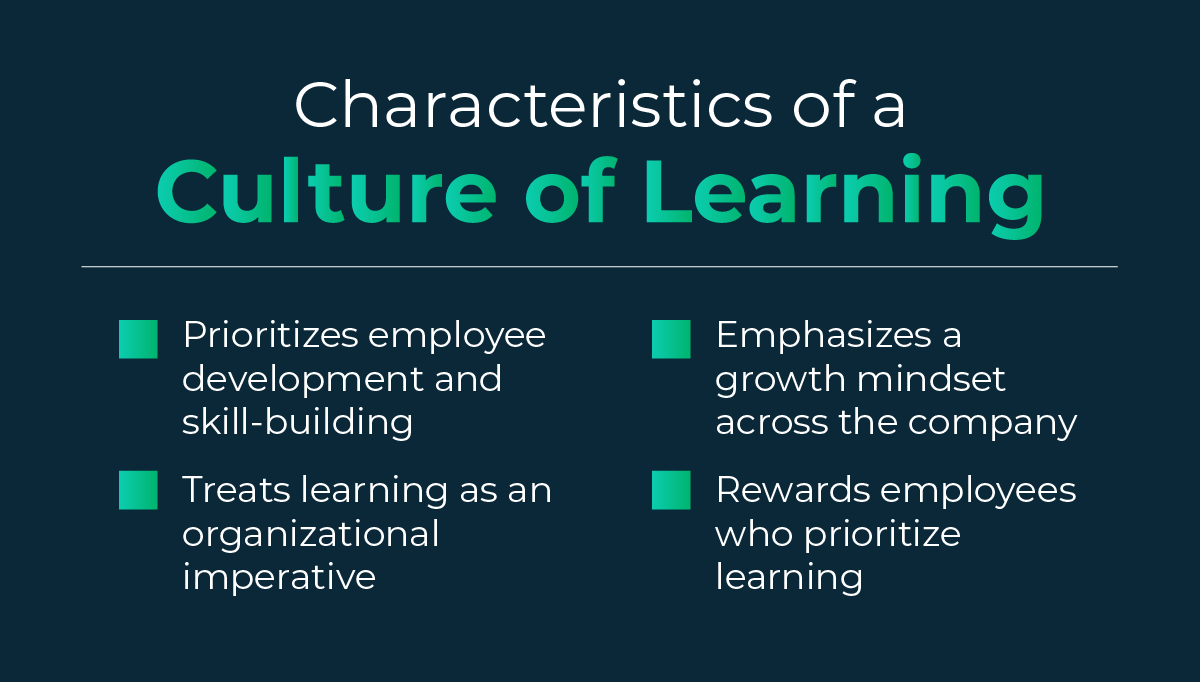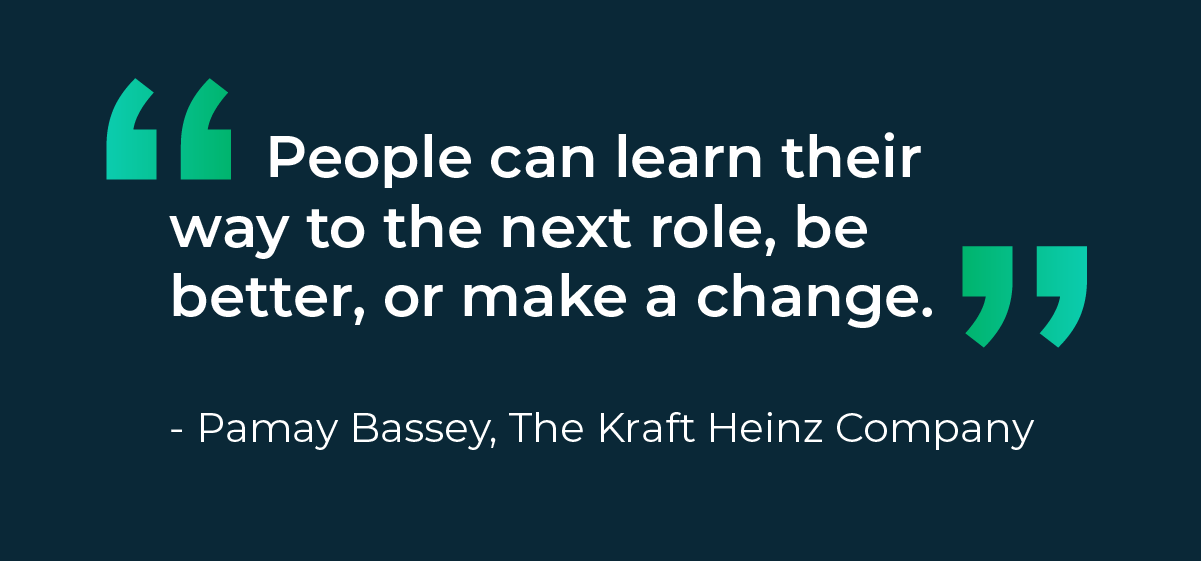How to Create a Culture of Learning in the Workplace

As technology and business processes evolve, economists and business leaders agree that upskilling and reskilling your employees can help your organization remain competitive.
But skill-focused training programs alone aren’t enough to meet the complex demands of today’s marketplace. You will need agile, thoughtful employees who can think innovatively and strategically, which requires a broader cultural commitment to learning and development.
What Is a Culture of Learning?
An organizational culture of learning prioritizes individual development, upskilling and reskilling, and knowledge sharing and treats those goals as organizational imperatives. In a true learning culture, leaders and workers have a growth mindset, meaning they believe in their capacity to improve and develop within and outside their roles.
Companies with a clear culture of learning definition reward and promote employees who engage in learning and development. This creates a cycle of positive reinforcement that can motivate your employees at all levels.
The Importance of a Learning Culture
In today’s economy, a learning culture is no longer a nice-to-have. You can quickly fall behind your competitors if you don’t commit to continuous learning and development.
A 2022 study in the VINE Journal of Information and Knowledge Management Systems found that a strong organizational learning culture led to increased knowledge sharing, stronger employee competencies, and organizational effectiveness. Similarly, a report from the United Kingdom’s Chartered Institute of Personnel and Development stated that organizations with the most effective learning cultures show increased productivity, growth, and profitability. A positive learning culture also increases employee loyalty and decreases turnover intentions.
These outcomes proved particularly crucial within the context of the COVID-19 pandemic. According to the MIT Sloan Management Review, companies with a robust preexisting learning culture were better able to adapt quickly to new ways of working.
Creating a Culture of Learning
Simply offering learning opportunities like access to online courses or other professional development opportunities is not enough to create an authentic learning culture. Corporate learning programs are widely underutilized—in the U.S., less than 10% of employees eligible for tuition reimbursement programs take advantage of them.
One major reason is that companies offer learning programs without building a culture that encourages and supports employees in their development efforts. Here are seven ways organizations can create a culture of learning.
1. Ensure Buy-In from Leaders
As Pamay Bassey, Chief Learning and Diversity Officer for The Kraft Heinz Company, shared in a recent conversation with Emeritus, your employees will need encouragement from both company executives and their managers to participate in learning activities. That’s why Kraft Heinz tracks both individuals’ engagement with learning opportunities and managers’ efforts to get their teams involved.
“We believe that, given the right support and scaffolding, people can learn their way to the next role, be better, or make a change,” Bassey said.
2. Carve Out Time for Learning
Corporate learning expert Josh Bersin found that across more than 700 companies surveyed, the average employee only had 24 minutes per week to spend on learning and development. True skills development requires significantly more time, so leaders must ensure that employees have room in their day and the bandwidth to focus on their education while meeting company goals.
This may mean reducing individual employees’ deliverables while they take a course or making use of less busy seasons for specific units to focus on upskilling and reskilling.
3. Engage in Career Pathing
Learning programs require significant employee engagement. To stay motivated, employees must understand what payoffs they can expect from upskilling and reskilling. The process of career pathing, in which managers work with employees to lay out their potential trajectory through their organization, can help maximize engagement.
A well-developed career path encompasses an employee’s specific professional goals and identifies the skills and learning they will need to develop to achieve those goals. When you tie learning outcomes to professional advancement, employees are far more likely to see the value of the programs.
4. Check In and Give Feedback Regularly
Every individual learns differently—and every employee brings their own level of background knowledge. Plus, different day-to-day responsibilities mean that one employee might struggle to keep up with the workload of a formal learning program that fits perfectly into another’s day.
That’s why it’s essential for managers to regularly check in with their employees to assess what they are gaining from a learning program, how they are balancing it with their other responsibilities, and how they can start putting their learning into practice. Similarly, as employees begin to engage these new skills in their roles, frequent feedback on their performance will help them refine and cement those new learnings.
5. Lead by Example
As the Harvard Business Review points out, leaders’ behaviors can significantly impact your employees’ actions in the workplace. When leaders model their own learning and talk about it openly with their employees, they reinforce a learning culture and show that developing new skills and capacities is a priority for every member of the organization.
While executive team members may not participate directly in learning programs, frequently emphasizing the importance of learning in company meetings and communications can provide helpful reinforcement for middle managers.
6. Support Risk-Taking
Steve Suarez, Global Head of Innovation for Global Functions at HSBC, explained at a recent Emeritus digital event that innovative cultures can only develop when employees are empowered to take risks. While failure is uncomfortable, it’s a valuable tool for learning and growth.
When employees see that it’s “safe” to fail in the context of learning and innovation, they will be more comfortable stretching themselves and embracing growth. As employees develop new skills, allowing them to test them out on lower-stakes projects–even if more experienced employees are available–will help you build the next generation of talent.
7. Measure and Reward Learning Efforts
Learning and development demand time and attention—and it’s essential that employees feel their efforts are recognized. Adding learning metrics to your annual goals and performance reviews and rewarding employees who go above and beyond to learn new skills and abilities will go a long way toward encouraging participation.
Ultimately, tracking employees’ engagement with learning programs can also be tied into a broader skills measurement program to help the company keep tabs on skills gaps and build out new functionalities.
Is your organization working to develop a learning culture? Reach out to Emeritus Enterprise to learn how we can customize learning programs to meet your teams’ specific development needs.




